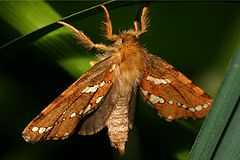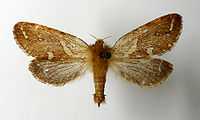Gold Swift
| Gold Swift | |
|---|---|
 | |
| Scientific classification | |
| Kingdom: | Animalia |
| Phylum: | Arthropoda |
| Class: | Insecta |
| Order: | Lepidoptera |
| Family: | Hepialidae |
| Genus: | Phymatopus |
| Species: | P. hecta |
| Binomial name | |
| Phymatopus hecta (Linnaeus, 1758) | |
| Synonyms | |
| |
The Gold Swift (Phymatopus hecta) is a species of moth belonging to the family Hepialidae. Until recently it was placed in the genus Hepialus. It is a widespread species of Europe, its distribution following that of its foodplant, bracken.

This is a rather small moth for the family, with a wingspan of 26–32 mm. The male is distinctive, the brown forewings marked with two parallel bands of gold markings. The larger female is less striking with muted grey and brown markings. The adult is on the wing in June and July and both sexes are moderately attracted to light. To attract females, the male emits a scent rather similar to pineapple.
The larva feeds internally on the stems and roots of bracken, taking two years to reach full size, when it emerges to pupate in the ground.
- ^ The flight season refers to the British Isles. This may vary in other parts of the range.
References
- Skinner, Bernard Colour Identification Guide to Moths of the British Isles 1984
- Waring, Paul & Townsend, Martin Field Guide to the Moths of Great Britain and Ireland 2003